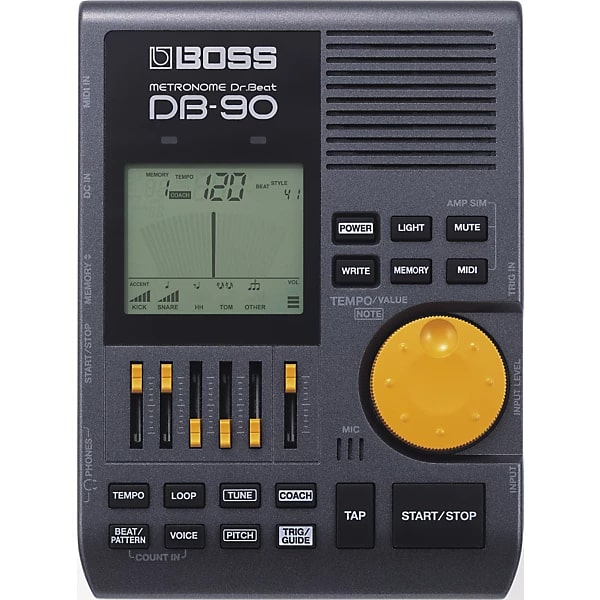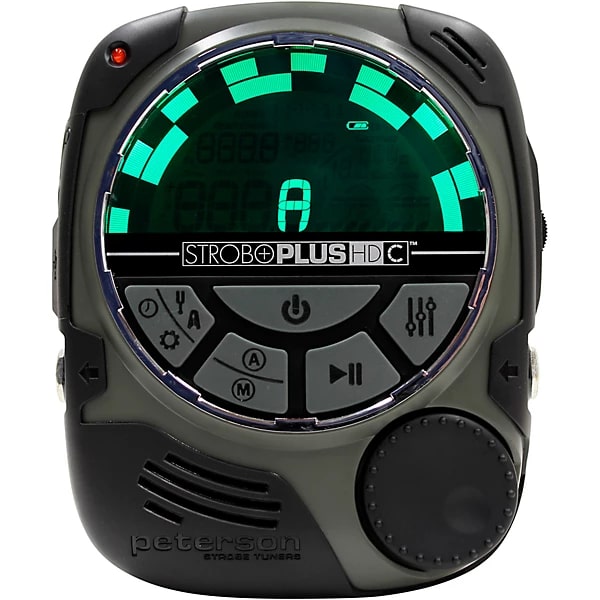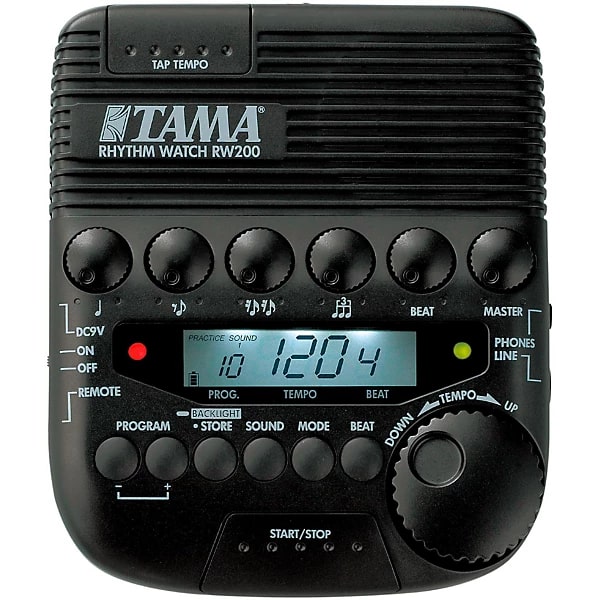When you buy through our links, we may earn an affiliate commission.
When it comes to learning, practicing, and writing music, one of the most useful tools at any musician’s disposal is a metronome. This simple timekeeping tool has evolved a lot over the years.
They help reinforce keeping a steady beat and make for more productive practice sessions. Modern metronomes come in physical and software formats, and most offer a number of features that let you tailor them to individual preferences.
Metronomes can be frustrating to use at first, but practicing and playing with one consistently solidifies your timing, rhythm, and phrasing skills.
Our top pick for the best metronome is the BOSS DB 90 Dr. Beat due to its range of features and level of customization.
Let’s run down our picks for the best metronomes and some of the features to be aware of so you can choose the best model for you.
Quick Summary of the Best Metronomes
- BOSS DB-90 Dr. Beat (Best Metronome Overall)
- Soundbrenner Core Steel 4-in-1 Smart Music Tool (Best Next-Generation Metronome)
- Wittner Wood Metronome (Best Mechanical Metronome)
- Korg TM-60 (Best Compact Metronome)
- Peterson StroboPlus HDC (Best Metronome/Tuner Hybrid)
- Tama RW200 Rhythm Watch (Best Metronome for Drummers)
- Soundbrenner Metronome (Best Metronome App)
Best Metronomes
1. Best Metronome Overall – BOSS DB 90 Dr. Beat

SPECS
- Tempo Range: 30-250bpm
- Time Signatures/Subdivisions: Yes
- Additional Features: Instrument, trigger, footswitch inputs, PCM drum sounds, learning tools, MIDI I/O, multiple click sounds, human voice count-in
Who would have thought our winner for the best metronome would come from a company most known for guitar pedals? It’s hard to pick a “best of” in any category, but the BOSS DB-90 is a clear winner in the best metronome conversation.
The DB-90 Dr. Beat straddles the line between a digital metronome and a drum machine, and it offers a range of useful features, onboard sounds, and learning tools all at a very affordable price point.
You can adjust four different click sounds, and the human voice count adds flexibility. It also offers a number of practice drum patterns in different styles and genres and onboard PCM drum samples to play along with.
Note Mixing lets you customize rhythm patterns across five note values. Note parameters are adjusted through an easy front panel control set of sliders, buttons, and a global control knob.
The Rhythm Coach training helps augment your skills by making practice interesting. And once you dial in the perfect tempo, you can store your sounds across 50 banks of presets for instant recall.
Via the direct input, the tuner can be used with guitar or bass, and there’s an amp simulator that can be bypassed. This makes the DB-90 a great, versatile practice tool regardless of what instrument you play.
The lightweight frame makes it easily portable for live use, and through MIDI, it can sync to an external sequencer. A backlit LCD screen provides a visual readout of tempo and subdivision settings. It isn’t very large, but BOSS did a good job at making sure the screen isn’t too cluttered.
The DB-90 is an all-in-one tool for keeping time that’s a great choice for any musician. With a digital metronome feature set perfect for professional live performance, the number of learning mechanisms makes it great for beginners or just keeping your rhythm skills sharp.
Can BOSS do no wrong?
2. Best Wearable Metronome – Soundbrenner Core Steel 4-in-1 Smart Music Tool

SPECS
- Tempo Range: 20-400 bpm
- Multiple time Signatures/subdivisions: Yes
- Additional Features: Tap tempo function, contact tuner, decibel meter, smartwatch functions, Bluetooth tempo synchronization
I bet you never thought you could wear a metronome. This means that you don’t just hear the beat from this digital metronome; you feel it. This alone makes it a great choice for drummers, especially where monitoring can be tough due to the volume of the instrument.
With a tempo range of 20bpm, all the way up to an insane 400bpm, it doesn’t matter if you play thrash metal or acoustic folk; it’s useful for musicians of any genre. The battery can last over five days, depending on how it’s used.
It sports the sleek look of a smartwatch and comes in two finishes, making it just as much a fashion piece as a musical tool.
This is one of the best vibrating metronomes. It's on the expensive side but think of it as an investment. The additional features provide value far beyond just timekeeping.
If you can’t stand the sound of a click, this is one of the best metronome alternatives. And a vibrating metronome means it won’t get lost in the energy of the moment when you’re playing.
The advanced features and range of utilities make this one of the best metronomes on the market.
3. Best Mechanical Metronome – Wittner Wood Metronome

SPECS
- Tempo Range: 40-208 bpm
- Multiple time Signatures/subdivisions: No
- Additional Features: None
They’re not nearly as popular as they used to be, but mechanical metronomes still have their place. There’s something to be said about their simplistic function and classic aesthetic.
Made out of dark brown walnut, the Wood metronome is manufactured with fine German craftsmanship. A removable face plate helps to keep dust and dirt out of it when it’s not in use.
There are some downsides to mechanical metronomes. It doesn’t offer a tap tempo feature or beat subdivisions. No I/O means it’s not good for live work, and there are no additional features.
But there’s an elegant simplicity to an analog metronome that just works. And sometimes, a simple metronome is all you need. If you're looking for a traditional metronome, this is one of the better choices.
4. Best Compact Metronome – KORG TM-60

SPECS
- Tempo Range: 30-252bpm
- Time Signatures/Subdivisions: Yes
- Additional Features: Rhythm variations, reference tuner, auto power-off, built-in stand, tap tempo
What guitar player hasn’t had one of these digital metronomes like this in their guitar case at one point?
Small metronome/tuner combos like this are great for on-the-go musicians, and its small size makes it great to throw in a case or gig bag.
The tuner and the metronome can be used simultaneously. There are 15 onboard rhythms in multiple styles to make practicing more interesting. Tuner detection ranges from C1 to C8 octaves.
This means it works on almost any instrument. Guitar and bass are a given, but you can use it for piano, brass, woodwinds, and strings.
Calibration is a critical step to make sure metronomes and tuners are set properly. The TM-60’s Memory Backup saves the calibration, so you won’t have to do it last minute.
A backlit display and built-in stand provide an easy view. It’s a cheap metronome (inexpensive), compact, and uncomplicated.
5. Best Metronome/Tuner Hybrid – Peterson StroboPlus HDC

SPECS
- Tempo Range: 10-280bpm
- Time Signatures/Subdivisions: Yes
- Additional Features: Tempo maps, five different voices, pattern accents, multiple display colors, Peterson Connect app integration
What if you don't want "just a metronome"? Timing and tuning are two of the most important concepts of music. There are a lot of metronome and chromatic tuner hybrids, but none do this combination better than Person’s StroboPlus HDC.
This gives it the distinction of being one of the most advanced metronome tools on the market.
Personalization is the name of the game here, and with this advanced metronome, almost every parameter can be edited using a combination of the simple control set. It provides ways to divide the beat and provides metronome sounds that other models can’t come close to.
The metering is complex and allows for time signatures that other metronomes don’t. All of this adds up to a nice challenging element when using it for practice.
It comes stock with 100 preset banks, and you can overwrite these with whatever patches best suit you. But tempo mapping is one of the coolest features.
Think of them like a song arrangement based on the tempo of each song section. They become even more useful if a song changes timing throughout its duration.
You can set the metronome to follow along with the arrangement. It also allows you to load custom tempo maps for fleshing out songs. This comes in extremely handy if you play a style of music that has a lot of timing changes.
The only downside is you have to use Peterson’s Tempo Map Designer to piece them together and then transfer them to the device.
The face of the unit offers a number of controls, and almost every setting can be edited through the Peterson Connect app. For monitoring, there is an onboard speaker, or you can output the signal through the 3.5mm TRS headphone jack connection.
But what if you want to feel the beat rather than hear it? Peterson’s Vibe Out jack lets you do just that by connecting it to the Vibe-Clip accessory that’s sold separately.
The StroboPlus HDC won’t appeal to everyone. With a versatile metronome and a set of multiple tuning modes this advanced, it makes sense that the cost will reflect that. And factoring in everything the tuning engine offers, some might need something more simplistic.
But the depth of features under the hood is truly amazing. If you’re a professional that needs a sophisticated, workhorse metronome/tuner hybrid or you’re looking for a next-generation tool to help advance your skill set, this is one of the best investments you can make.
6. Best Metronome for Drummers – Tama RW200 Rhythm Watch

SPECS
- Tempo Range: 35-250bpm
- Time Signatures/Subdivisions: Yes
- Additional Features: Tempo and beat memory, mountable (with clamp)
Drummers are the heartbeat of any band, so they need to be as "in the pocket" as possible to provide a solid foundation for the other instrumentation.
It’s certainly not just for drummers, but it provides a lot of benefits for them, making it one of the best digital metronomes.
Everyone needs to hear the metronome in the way that best suits them, and Tama took that into consideration. It provides multiple ways to slice and dice the beat subdivisions, and there are storage banks for 30 tempos and beats.
This lets you create setlists and song sequences that can easily be recalled, swapped, and edited. A large, easy-to-access dial knob makes it easy to make tempo adjustments or scroll through settings quickly.
Drums are loud, and one of the most difficult things about using a metronome when playing them is being able to monitor the beat properly.
Separate volume controls allow you to set the beat divisions to exactly what you need to hear. You can monitor through headphones or send a line-out signal to the front-of-house for stage monitoring.
A backlit LCD display compensates for dark environments, though the readout is on the smaller side, so you’ll still need it fairly close to you. But the fact that it can be mounted on the drum kit somewhat compensates for this.
The Rhythm Watch is just as useful for keeping your chops sharp as it is for getting into the rhythm of live sets.
So if you’re a drummer that’s tried different types of metronomes to no avail, the Rhythm Watch aims to be the metronome you’ve been looking for. And at just under $100, it won’t break the bank either.
7. Best Metronome App – Soundbrenner Metronome

SPECS
- Tempo Range: 20-400bpm
- Time Signatures/Subdivisions: Yes
- Additional Features: Educational resources, tap tempo, library for saving songs, Soundbrenner wearable integration
The digital metronome maestros as Soundbrenner not only make some next-generation physical products. They created one of the best timekeeping apps in Metronome. It not only integrates into their hardware models, but it’s also a fantastic standalone product as well.
One of the reasons Metronome edges out other similar apps is how customizable it is. This is one of the advantages that metronome apps have over their hardware counterparts.
You can set the volume of each quarter note on a scale of one to three. This lets you tailor how you hear each click depending on how you like the pulse to be accented.
15 beat variations and subdivisions let you slice and dice the wide tempo range in whatever way you need. You can easily save your tempos and arrange them into categories.
There are also a number of learning resources that teach you concepts like unusual meters, polyrhythms, and how to make the app work better for you.
If you’re using software metronomes, there are different considerations to take in mind, especially if you want to use it with a live band. You’ll need some way to monitor the tempo, whether it’s through playback or a visual cue. Luckily you can output the playback through an auxiliary cable.
Metronome runs on Android and iOS devices, and it’s free to download, though some of the high-level features do require a buy-in.
Overall it’s a solid choice if you’re looking for a metronome app, and the educational resources are useful for beginners and advanced players alike.
Best Metronome Buyer's Guide
Metronome designs have come a long way over the years, and a style that works for one musician won’t necessarily work for another.
And with the advancements in technology they’ve made, you now have a much larger range of features to consider than just tempo and time signatures.
Tempo Range
Because it’s the core of what a metronome does, tempo range is a big factor in selecting one. Any metronome will give you a wide range of tempos, but certain models offer more extreme settings on either end of the speed spectrum.
While going either way in tempo direction isn’t that useful for songwriting and recording, it’s fantastic for practice. Challenging yourself is one of the best - if not the best - ways to get better at your musical instrument.
But any metronome needs to be precise. Which brings us to the next topic.
Precision
A metronome needs to be accurate when it comes to tempo, time signatures, and subdivisions. This isn’t so much of a concern anymore, but it’s not uncommon for low-quality metronomes to jump around in speed.
Even if the click isn’t off drastically, even a few milliseconds can be noticeable. Even worse is the counterintuitive impact it has on using it.
Time Signatures and Subdivisions
By choosing a metronome that offers time signatures beyond 4/4, you open yourself up to a world of options. Most standard-quality metronomes will offer other common time signatures like 6/8 and 3/4. Some will go beyond the normal and offer unique timings like 6/4, 5/4, 7/8, or even 7/4.
And within those time signatures are multiple ways you can subdivide the beat. By being able to play along with them, you have additional ways to practice.
This comes in handy for musicians who have a certain way they like to hear things, like playing along to a 4/4 beat with ⅛ notes instead of ¼ notes.
Display and Monitoring
These fall into the same category because they both address how you perceive the metronome. Some prefer to simply hear it, others need a visual timekeeping cue, and there are always those players that prefer to use or have the option of both.
But there’s a third option that more modern metronomes have brought forward - feeling the beat. There are a lot of models that offer wearable utility or ways to output the tempo to external sequencers.
Keeping in sync with a metronome is contingent on being able to monitor it properly.
Modern Features
Metronomes have been around since the early 19th century. They stayed the same in concept and design until over a century later when electronic metronomes were released.
And a musical tool that was designed to be as simple as possible now offers a mind-blowing number of ways you can use it.
Modernized metronomes evolved to offer features like different time signatures and subdivisions. The standard click sound wasn’t your only option anymore, and you could set different sounds and volumes for the beats.
They’re much more than just a timekeeping tool now. Some have tuning capability, decibel metering, onboard rhythms for more in-depth practice, and even drum machine sounds!
One of the most feature-rich metronomes is the Core line from Soundbrenner. They’re a metronome and much more in a smartwatch profile!
Frequently Asked Questions (FAQs)
What are metronomes used for?
Sometimes referred to as a click track, metronomes are a tool for keeping consistent time when playing or practicing music. By keeping a steady tempo, it helps players stay “in the pocket” to maintain a steady groove.
How do I choose a metronome?
When shopping for a metronome, you need to assess what instrument you play and how you’re going to use the tool. If you just need something simple, a handheld model might be the best choice.
And if you’re a professional musician, you might need to invest in a more advanced model that offers more ways to shape the beat.
Conclusion
No matter what instrument or style of music you play, a metronome is a key tool to help you improve your timing. For advanced players and beginners alike, it helps you sharpen your timing and rhythm skills and keep them sharp.
If you're looking for a metronome that offers a wide range of features and allows for a high degree of customization, then we highly recommend the BOSS DB 90 Dr. Beat.
Just as useful for simple rehearsal as it is for songwriting, a metronome also helps you get ready for the recording studio. They’re such an integral part of the music process that they’re included in every digital audio workstation.
From simple to sophisticated, there are so many different types of metronomes on the market that, with a little research, you can find the perfect model for you. And you’ll be a better musician for it.
